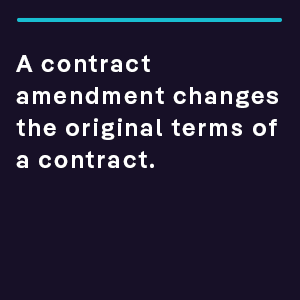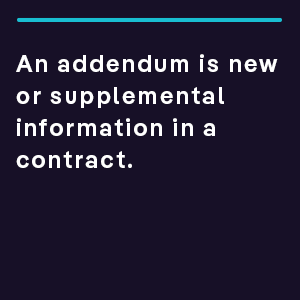We all know that from time to time, contracts need to be amended, changed, or updated. But what is the appropriate form to do this? Legal professionals often use the expressions, “contract addendums” or “contract amendments,” interchangeably. But in actual fact, they are slightly different.
So, to help you understand which terms to use — and when to use them exactly — please read on!
What is a Contract Amendment, and When Should It Be Used? 
A contract amendment changes the original terms of a contract. It sets out changes that have been agreed to by the original signing parties. For example, the parties may agree to adjust pricing terms; change the scope of works; or agree to add additional services and adjust the overall price. An amendment may be as simple as extending the agreed length of term for the supply of services, but a substantive change to the original agreement is still needed.
What is an Addendum?
An addendum is new or supplemental information in a contract. It can be used to add information — like an expiry date — that should have been included in an original agreement. Or it could be used to supplement a contract at the time that it is entered into — for example, taking ownership of store fixtures or office furniture in a real estate sale. For the most part, addendums contain new contract language, terms, or substance and serve as attachments to the original agreement.
Approval authority
In either case, the document will have legal force. So, sign-off approvals should follow your standard approvals process, depending on the value of the deal. Generally, when a contract is amended, the person who approved the original contract should be the person approving the change.
Contract amendments and risk management 
Professional services companies like consulting firms often write up change orders when the scope, duration, or project details are modified during delivery. Generally, change orders and order forms are considered as amendments — even though they are documents that are separate from the core contract.
Change management is crucial to all parties to a contract. To a consulting company working under a statement of work (SOW) or master services agreement (MSA), jointly signed change orders explain why project deliverables from an original contract were not met. If the consulting company were to invoice their client for the original scope of work, the client can simply refer to the change order.
Oral agreements on deviations from approved contract language are especially fraught with risk. Amending a contract, then, can safeguard your interests and satisfy compliance regulators. Change orders — or requests — protect consulting companies, should their client claim the consultant breached the contract because they did not meet all of their obligations under the original terms.
Using a Contract Management Solution to Manage Addendums and Amendments
It is vital that your organization is aware of the most up-to-date, agreed-upon arrangements under a contract. If amendments to the original contract — or, indeed, addenda — are not stored together, it can be easy to overlook an obligation. The good news is a contract lifecycle management (CLM) solution can help your organization keep track of amendments to original agreements. Contract repositories, in particular, make it easier to find clauses, supporting documents, and amendment examples from previous agreements. In addition, a CLM platform helps manage every contract version throughout its lifecycle: change requests, redlines, and electronic signatures.
So, now that you know the difference between contract addendums vs amendments, perhaps you want to get a better handle on either by improving your own contract and change management. If you are interested in adopting a legal platform to achieve that end, contact ContractPodAi today and book a demo.
Further Reading:



